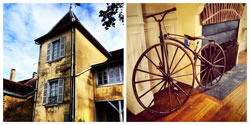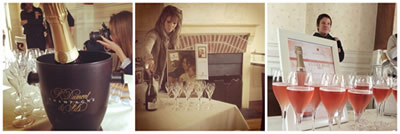|
The beautiful Champagne city of Troyes is 8 hours drive from Bordeaux. This was our destination to celebrate the 5th annual Champagne Day. The first thing I realized was that October, season of autumn, probably is one of the more beautiful seasons, perfect calendar time if you want to visit Champagne region, when it is still not too cold.
Our first stop was Champagne Veuve Devaux. It is in Bar-sur-Seine, in the heart of the Champagne region, in the Côte des Bar.
.How to get here: follow the map/directions
Following are the champagnes we tasted:
 1.D Millésime: 50% Pinot Noir & 50% Chardonnay (% age varies depending on vintage) 1.D Millésime: 50% Pinot Noir & 50% Chardonnay (% age varies depending on vintage)
Vinification: Minimum 7 years in the cave. BRUT - Dosage: 6g/l after which bottles are conserved for 6 to 9 months in the cave (cellar)
Aromas: peach, citrus, almond, hazelnut
Food Pairing: cream coated with crusty jelly, shrimps on toppings, peer, Coriander leaf for dressing.
2.Ultra D: 60% Pinot Noir & 40% Chardonnay (% age varies depending on vintage)
Vinification: Minimum 5 years in cave. EXTRA BRUT - Dosage: 2g/l.
Bottle conservation from 6 to 9 months in cave.
Aromas: dry fruits, spices
Food Pairing: seafood #scallops in France known as coquille saint jacques, dressed with tiny diced carrot and #chives, in France commonly known as ciboulette, mostly served with seafood, fish
3.D Rosé: 50% Pinot Noir & 50% Chardonnay (depending on vintage)
Vinification: Minimum 5 years in cave. BRUT - Dosage: 8g/l. Another conservation from 6 to 9 months in cave
Aromas: red fruits, red berries, apricot, licorice, (known as réglisse in France)
Food Pairing: Lobster, in France we call it #Homard, all soaked in champagne, and dressed with strawberry.
4.Cuvée D 60% Pinot Noir & 40% Chardonnay (depending on vintage year)
Vinification: Minimum 5 years in cave. BRUT - Dosage: 8g/l. Another conservation from 6 to 9 months in cave
Aromas: café, vanilla
Food Pairing: fois gras wrapped in ham, we call #jambon in France. It was simply delicious.
Champagne house Richardot
Situated in in the heart of the Côte des Bar, in the southernmost part of Champagne
Family Richard has been harvesting for two generations. You will find their pressing centre, the local winemaking and hospitality at Loches-sur-Ource, and the vineyard is located in the charming village of Essoyes (small tourist center which is seduced by its time of painter Renoir).
How to get hear: follow map/directions
With Lunch: Brut Tradition
This champagne is characterized by notes of zesty and white flowers. A beautiful freshness and color with green gold shades, this champagne is composed of 80% Pinot Noir and 20% Chardonnay. The Champagne vineyards feature three varieties:
* Pinot Noir which gives more robust wines
* Pinot Meunier gives fruitier wines and low acid
* Chardonnay produces freshness and finesse in assemblage
List of Champagne produced by the family Richard
 Troyes specialty: Chaource Cheese, one of 33 controlled designations (A.O.C.) Troyes specialty: Chaource Cheese, one of 33 controlled designations (A.O.C.)
Du Cote Des Renoir- Essoyes dans l'Aube
Two-and-a-half hours southeast of Paris, in the part of Champagne that borders Burgundy, is this lovely little village. Today visitors to Essoyes can learn about the life of the famous painter Renoir’s family at the Atelier Renoir, and enjoy the landscape as well. Essoyes still remains “more or less unspoiled.” l’art de vivre
For more information click HERE
 Like Renoir, one could stay happily in Essoyes for a long time, simply enjoying the beauty of the countryside and the peaceful pace of life, exploring its quiet pleasures, being welcomed at the many caves in the nearby area, where local vintners are happy to provide visitors with dégustation of exquisite champagnes not found anywhere else on earth. Like Renoir, one could stay happily in Essoyes for a long time, simply enjoying the beauty of the countryside and the peaceful pace of life, exploring its quiet pleasures, being welcomed at the many caves in the nearby area, where local vintners are happy to provide visitors with dégustation of exquisite champagnes not found anywhere else on earth.
The area also offers numerous possibilities for recreation, amusement, visits to historic sites and other places of interest. Don’t miss the stained-glass windows of Saint-Pierre-et-Saint-Paul Cathedral, dating from the 13th-19th centuries. Make sure you visit before 4PM.
How to get here: follow map/direction
Le Celler St' Pierre a 12th Century Building (a must visit)
 Our last stop of the day was the cellar of Saint Pierre, opposite to the Saint-Pierre-et-Saint-Paul Cathedral. We were welcomed by the caviste (cellarman). For those who don't know the purpose of a wine cellar, here is a small definition - A wine cellar is basically a storage room, most importantly in which temperature and humidity are maintained by a climate control system. In contrast, passive wine cellars are not climate-controlled, and are usually built underground to reduce temperature swings. Our last stop of the day was the cellar of Saint Pierre, opposite to the Saint-Pierre-et-Saint-Paul Cathedral. We were welcomed by the caviste (cellarman). For those who don't know the purpose of a wine cellar, here is a small definition - A wine cellar is basically a storage room, most importantly in which temperature and humidity are maintained by a climate control system. In contrast, passive wine cellars are not climate-controlled, and are usually built underground to reduce temperature swings.
A fine place to purchase bubbly and Aube wines such as Rosé des Riceys.
Before heading to the underground cellar, let's discover their local gin called Prunelle. With Monsieur caviste himself, we head to the distillery. Troyes sloe (blackthorn fruit) gin is made using its original recipe right here!
Interesting facts:
· It won a gold medal at the Paris international exhibition in 1900.
· The cellar has been used since 1840 to distil Prunelle de Troyes, a 40% liqueur made with sloe (blackthorn fruit). Sunday and Monday they are closed.
Interesting facts:
· The cellar tunnel leading to the cathedral.
· It won a gold medal at the Paris international exhibition in 1900.
· The cellar has been used since 1840 to distil Prunelle de Troyes, a 40% liqueur made with sloe (blackthorn fruit)
·
Pascal Caffet - Chocolatier - Pâtissier - Troyes
Pascal Caffet is a World Champion French pastry confectioner and chocolate maker. He has shops in France, Italy and in Japan. It is like indulging fine luxury that we got treated during our dégustation at the cellar of St. Peters. Chocolates and pastries are to die for. Richness of cacao, different flavours, nuts, typical grapes from champagne oozes here.
For information click HERE
Visiting Les Riceys and Champagne Horiot
 In the southern-most part of the Champagne region, the Côte des Bar in the Aube department, there is the town of Les Riceys, where the slopes are blessed with the portlandian formation of Kimmeridgian clay, (calcareous clay containing Kimmeridgian limestone, the principal soil type of the Loire Valley, Champagne and Burgundy regions). Besides here the idea was to plant Pinot Noir on these chalky slopes, do a long maceration, often using whole bunches, and then age it a few years (at least 3) before release. In the southern-most part of the Champagne region, the Côte des Bar in the Aube department, there is the town of Les Riceys, where the slopes are blessed with the portlandian formation of Kimmeridgian clay, (calcareous clay containing Kimmeridgian limestone, the principal soil type of the Loire Valley, Champagne and Burgundy regions). Besides here the idea was to plant Pinot Noir on these chalky slopes, do a long maceration, often using whole bunches, and then age it a few years (at least 3) before release.
Interview with Olivier Horiot
I visited Champagne Olivier Horiot and also interviewed Monsieur Olivier Horiot who took over the estate of his father Serge in 1999.
He immediately started using organic and some biodynamic practices and reoriented the winemaking to being more terroir-focused. In order to make the Rosé des Riceys, Olivier follows a very strict selection of grapes from two separate sites- en Valingrain and en Armont and vinifies them separately.
The wines start with about 10% of the grapes that are foot-trodden at the bottom of the cuve, then whole bunches are added. Macerations usually last 5-6 days with pumping over twice a day. After the wine is racked into older barrels, it remains there for a few years before being bottled without any fining or filtration.
· Rosé des Riceys requires the best south-facing hills.
· The reputation of Rosé des Riceys for aging is impressive.
· Rosé des Riceys appellation, dedicated exclusively to non-sparkling rosés, sharing the same Kimmeridgian soils with Chablis.
· The palate is feminine and floral with dried roses and berries. Great acidity and crystalline flavors made this quite exciting.
What inspired Olivier to start making own wines?
‘During my time in US, vinifying in the state of Washington. Where I worked, Chardonnay, Merlot, Cabernet Sauvignon, and Riesling were all planted together in the same vineyard!’
‘It struck in my mind as odd that they thought they could produce quality wine this way, but I later realized that they were simply trying to figure out what grape was best suited for this terroir. When I came home, I had that utterance. My family's land already had established grapes grown on established terroir. I also realized that with just one grape (Pinot Noir), you could produce many different styles of wine and still have them to be profound of a place.
Everyone makes Champagne, but we are only 15 who continue to make Rosé des Riceys. Our first sparkling was produced in 2004.’
Olivier also produces 4 Champagnes: a Blanc de Noir from the En Barmont vineyard named Sève, two blends of multiple parcels, 5 Sens and Métisse, as well as a quirky, unexpected Champagne produced with the Arbane grape, aptly named Arbane.
They all have very low dosages, never above 2 g. Most regions of France don't have this versatility. The magic of Les Riceys is that with Pinot Noir, you can make quality rosé, red, white, white Champagne and rosé Champagne. This makes it a truly unique place, says Olivier.
Les Riceys and its history as told by Olivier
The region of Champagne used to be extremely densely planted; vines were 40 centimeters from each other. There was no way to get a horse in there, and all the work had to be done by hand. These were reputed amongst the best red wines of France in medieval times.
The Riceys AOC was created in 1945. But prior to this, an insatiable group of growers had always produced rosé because it was THE local wine.
 Today, we are between 15 and 20 producers for a total production of 70,000 bottles a year. And in years like 2001 or 2007, no one made any because the quality wasn't there. So instead, everyone made bubbles. Today, we are between 15 and 20 producers for a total production of 70,000 bottles a year. And in years like 2001 or 2007, no one made any because the quality wasn't there. So instead, everyone made bubbles.
Indian Perspective
Indian Wine consumption has grown 25-30% annually over a 5 year period.
Indian women are beginning to prefer champagne and still wine as a more socially acceptable form of drinking for females. It is seen as more feminine to consume wine as opposed to the hard liquor that men are more traditionally seen consuming. In summary, I believe that Indian wine consumption has a huge potential.
Sanghamitra Banik
If you are planning a trip to #Champagne region you are welcome to contact Sanghamitra directly at sanghamitra.banik06@gmail.com. Best time to visit France is March, April, May, June, July, August, October (in August & October some of the chateaux are closed during harvest season) |